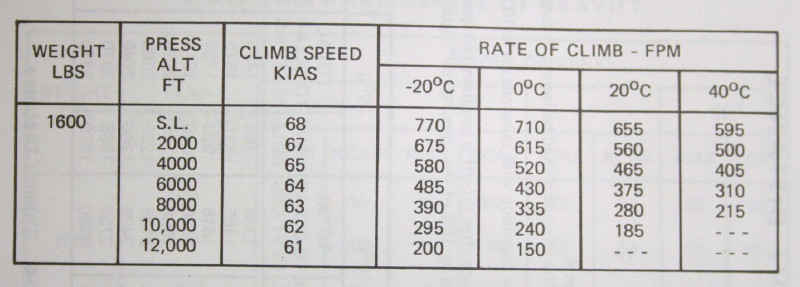During the preflight performance planning, pilots often need to interpolate to find the desired number. Interpolation is simply finding the "in between" number.
The chart below shows an airplane's expected climb performance at a weight of 1,600 pounds. At sea level and zero degrees, the rate of climb is shown as 710 feet per minute. At 20 degrees, the rate of climb is listed as 655 feet per minute. So, what rate of climb might be predicted by the manufacturer when the temperature is 10 degrees?
The first step to solving this problem is to find out how much the rate of climb changes per each degree of temperature change. The rate of climb varies from 710 to 655, a difference of 55 feet per minute, over a 20 degree temperature difference. Dividing 55 by 20 gives a 2.5 feet per minute change in climb rate per each degree temperature change.
The rate of climb change over ten degrees is then found by multiplying 2.5 times 10, 25 feet per minute. At ten degrees, the rate of climb is 25 feet per minute less than it is at zero degrees, which is 685 feet.
Another Example:
What is the approximate rate of climb at a pressure altitude of 6,400 feet and a temperature of 24 degrees?
Step One: What is the rate of climb at 6,000 feet and 24 degrees?
375 feet per minute - 310 feet per minute = 65 feet per minute climb rate range
65 feet per minute divided by the 20 degree temperature range = 3.25 FPM per degree
3.25 FPM per degree * 4 degrees = 13 FPM rate of climb change over a four degree temperature change
375 FPM - 13 FPM = 362 FPM at 6,000 feet and 24 degrees
Step Two: What is the rate of climb at 8,000 feet and 24 degrees?
280 FPM - 215 FPM = 65 feet per minute climb rate change
65 FPM over a 20 degree temperature range = 3.25 FPM per degree
3.25 FPM per degree * 4 degrees = 13 FPM rate of climb change over a four degree temperature change
280 FPM - 13 FPM = 267 FPM rate of climb at 8,000 feet and 24 degrees
Step Three: What is the rate of climb at 6,400 feet and 24 degrees?
362 FPM - 267 FPM = 95 FPM difference over 2,000 feet of altitude change
95 FPM / 2,000 feet = 0.0475 FPM per foot of altitude change
0.0475 FPM per foot * 400 feet = 19 FPM climb rate change
362 FPM at 6,000 - 19 FPM = 343 FPM at 6,400 feet and 24 degrees
This example could have been solved in a different order. The result would still have been 343 FPM. Some logical thinking is required, in order to make sure the interpolation is done correctly. For example, the answer to the interpolation should between the numbers being interpolated.
